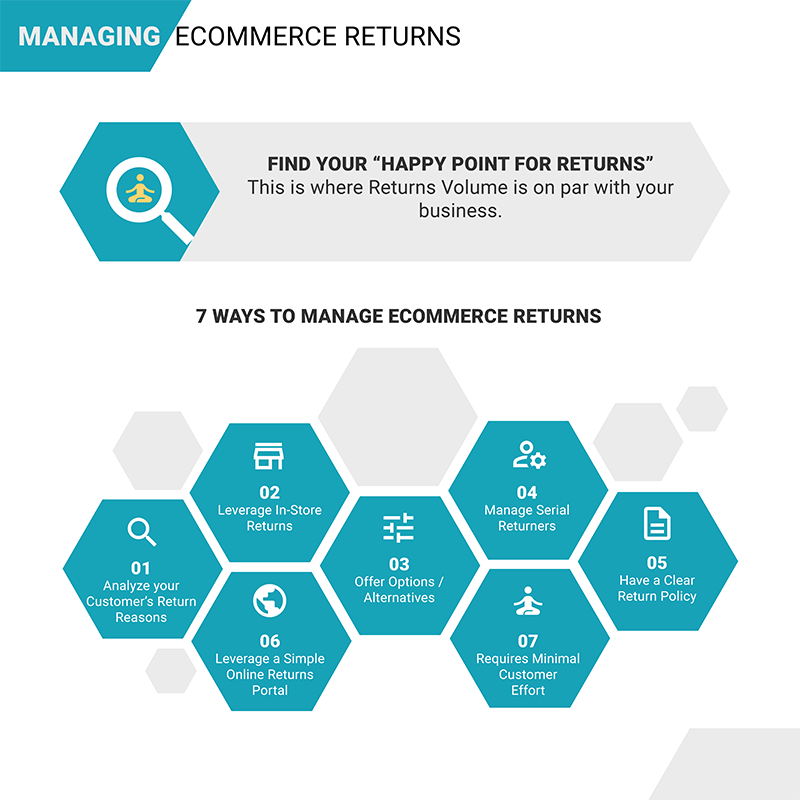
7 ways to Manage eCommerce Returns
By Commerce Returns
Published on May 26, 2021 - 3 Min Read
Customer returns are a healthy part of doing business, and so long as people are buying goods they will also periodically want to return them.
Managing eCommerce Returns centers around finding your stores Happy Point for Returns - that is a point where the return volume is in par with your business.

When trying to think of your stores Happy Point for Returns, consider the following:
- Rarely is a business so perfect that return volumes sit at this happy point.
- Volume that is above this happy point is return volume that should be within your control to reduce and eliminate.
- In order to Manage your eCommerce returns effectively, you must manage your Happy Point for Returns.
- Consider using our eCommerce Returns Software to automate and manage your returns effectively. Learn More
Below is a list of 7 points that we have seen to be proven ways to Manage your eCommerce Returns.
1. Analyze your customer's return reasons
Start collecting data on the return reason. Many of the return reasons can be actioned and reduced. Having a line of sight of the return reason allows you to action them accordingly.
With Commerce-Returns, our ecommerce returns software allows you to:
- Customize your own return reasons.
- Monitor the breakdown of return reasons.
For example: One customer we recently consulted with had 7% of their returns due to "Wrong product" being shipped. This customer every year had 7% extra return volume because of an edge case issue in their picking and packing process.

2. Leverage In-Store returns
If you have a brick and mortar store presence, enable these locations to accept your online returns. Showing each option on its own has its pros and cons, but when you stack the options next to one another the customer is forced to compare them and pick the best one. Giving your customers options reframes their mindset, and creates happier customers.
With Commerce-Returns, our ecommerce returns software allows you to:
- Save all your Store locations.
- Show your customers their closest location relative to their order address.
- Enable your customers to receive an e-tail purchase, but return it to your retail store.
- This is not limited to just Stores, but it can include any drop off location like a warehouse capable of receiving your returns.
For example: One of our customers who sells primarily low margin items has to charge small return fees for all online orders. By giving their customers the option to locate their nearest location and to drop it off free of charge, this customer was able to minimize the small number of frustrated customers who demanded free returns.

3. Give your customers Return Options / Alternatives
If you have a brick and mortar store presence, allow your customers to bring online orders back to your stores. Offer different returns options if its an exchange, vs a store credit, vs a refund. Analyze your product line, and determine what makes the most sense for you.
If you don't have a physical store presence, you can achieve similar results by offering other alternatives. For example, reducing return fees if the customer opts to recieve the refund in the form of a store credit rather than a refund, or offering a discount on their next purchase. Ultimately you must understand the motivations of your customers, and you must align your business goals to remain profitable and keep your customers happy.
With Commerce-Returns, our ecommerce returns software allows you to:
- Setup "Ship it Back" and/or "Bring it Back" options.
- Enable Refund, Exchange Request, and Store Credit as requested options.

4. Manage Serial Returners
A serial returner is a customer who habitually purchases with a clear intent to make returns.
There are two types:
- The Wardrober
- The Wardrober uses the item once and then returns it.
- Such customers typically do so because they are unable to afford the item.
- The Fitting Roomer
- The Fitting Roomer who purchases multiple sizes to keep what they like and to return the rest.
Dealing with Serial Returners
The first step in dealing with the Serial Returners is to setup a system to track and differentiate the types of returners. Any Serial Returners will get flagged, and can be automatically set to be charged higher return fees.
With Commerce-Returns, our ecommerce returns software allows you to monitor your customers, and flag those who are exhibiting Serial Returner behaviour.
The good news is that the majority of customers do not want to return items, they truly have a need for your product and they buy it to own it.
5. Have a clear return policy
Prior to hitting that buy button, customers look into your return policy. This moment can make or break a sale, so make sure that your return policy is easy to understand and gives your customers confidence to continue with their purchase.
Your customer's have better things to do than to spend a lot of time trying to understand what your return policy is. Make your return policy short, and simple to understand! For example, Lululemon's return policy is comprised of 5 bullet points.

6. Leverage a simple Online Returns Portal
In the 6 years of consulting with retailers, e-tailers, and their customers, the trend is clear - consumers want an easy to use online returns portal.
Find out today why Commerce-Returns offers the best eCommerce Returns experience. Learn More

7. Returns should require minimal effort by your customers
User friendliness reduces customer frustration. A customer wanting to initiate a return is already likely frustrated. Dont make the experience even more painful by having a clunky return process.
Commerce Returns web portal boils down the return process to 3 easy steps for your customers.

Questions?
If you would like to continue this discussion, feel free to reach out to us directly at [email protected]
